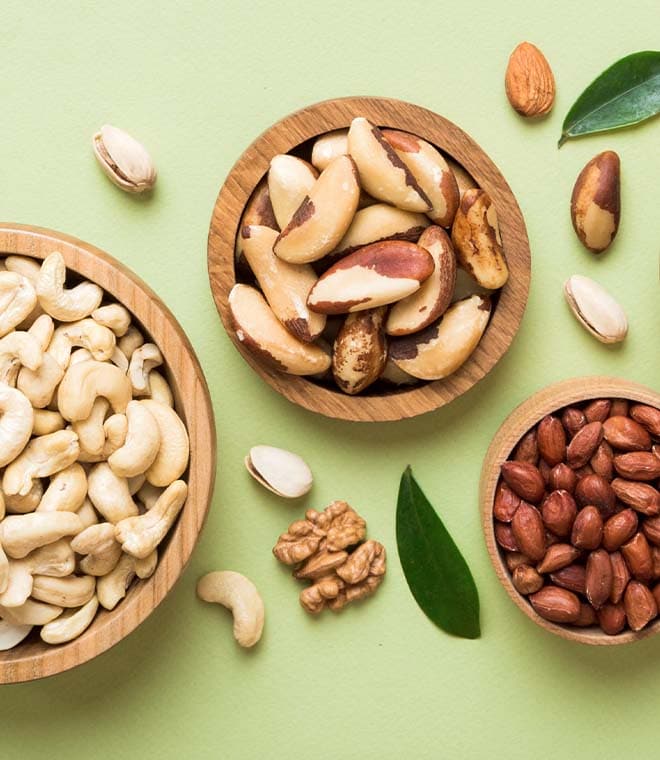Wellness
What are macronutrients?
By Michelle Katz, MS, RD, CDCES Oct 19, 2023 • 5 min
Nutrients are substances that your body needs to function properly. Macronutrients serve as the cornerstones to a healthy diet, so understanding what they are is an important first step in providing your body with what it needs to thrive.
Macronutrients defined
To produce energy, your body burns calories. Macronutrients are the substances in food that provide those necessary calories. The prefix macro means “large” and refers to the fact that your body needs large amounts of these nutrients.
Types of macronutrients
Three types of substances fall under the category of macronutrients. They include all of the following types of nutrients.
Carbohydrates
Commonly referred to as carbs, carbohydrates are your body’s primary source of energy. These macronutrients get converted to glucose, which your body can use right away as an energy source or store for future use.
There are three main types of carbohydrates:
- Sugars: These simple carbohydrates break down quickly. They occur naturally in foods like fruits and dairy and are added to sweets and processed foods.
- Starches: Starches are more complex than sugars, so they take longer to break down. They’re found in beans, legumes, whole grains and some vegetables like corn, peas and potatoes.
- Fiber: Most fiber doesn’t break down completely in the body and is used to regulate blood sugar and cholesterol levels, and to produce stool. Beans, legumes, fruits, nuts, seeds, whole grains and vegetables contain fiber.
Protein
Cells, tissues and organs are all made up of proteins, substances that are also present in foods. When you eat foods that contain protein, your body breaks down the macronutrients into amino acids, which it can then use to produce new proteins to replace old ones. Foods that contain protein include:
- Beef
- Dairy products
- Eggs
- Fish and seafood
- Legumes
- Nuts
- Pork
- Poultry
- Seeds
- Soy products like tofu
Fruits, non-starchy vegetables and whole grains also contain a small amount of protein.
Fats
While many people think of fats as bad for us, your body actually needs some amount of certain kinds of fat. When you exercise, your body burns stored fat for energy, and fats are an important component of the membranes that surround cells.
There are four types of fats:
- Trans fats: Found in partially hydrogenated oils as well as in beef and dairy products in small amounts, trans fats can contribute to inflammation and raise cholesterol. As a result, they should be avoided as much as possible.
- Saturated fats: Present in beef, cheese, bacon, sausage, whole milk and other foods, saturated fats are usually solid at room temperature and should be consumed in small amounts.
- Monounsaturated fats: One of the “good” fats, monounsaturated fats are found in nuts, avocados and seeds as well as olive, peanut and canola oils. These fats may help reduce bad cholesterol levels in your blood, which can lower the risk of heart disease and stroke.
- Polyunsaturated fats: Also considered a “good” fat, polyunsaturated fats come from fish, walnuts and flax seeds as well as sunflower, corn, soybean and flax seed oils.
Macronutrients vs. micronutrients
Micronutrients are another category of nutrients needed by the body. They include vitamins and minerals. The prefix micro means “small” and relates to the fact that your body requires micronutrients in much smaller quantities than it does macronutrients.
How much of each macronutrient do I need?
Guidelines for macronutrients intake are based on a percentage of the calories you consume:
- 45% to 65% of calories should come from carbohydrates, particularly fiber and starches
- 20% to 35% of calories should come from fat, particularly monounsaturated and polyunsaturated fats
- 10% to 35% of calories should come from protein
How many calories you should strive to consume daily depends on a variety of factors, including your age, level of activity and medical history. Your healthcare provider can give you specific advice about how many calories you need and how many of those calories should come from each macronutrient.
Published October 2023.
Sources:
- https://my.clevelandclinic.org/health/articles/15416-carbohydrates
- https://health.osu.edu/wellness/exercise-and-nutrition/micronutrients-vs-macronutrients
- https://www.merckmanuals.com/professional/nutritional-disorders/nutrition-general-considerations/overview-of-nutrition#v881321
- https://www.nal.usda.gov/human-nutrition-and-food-safety/food-composition/macronutrients
- https://www.hsph.harvard.edu/nutritionsource/what-should-you-eat/fats-and-cholesterol/types-of-fat/
- https://health.clevelandclinic.org/macronutrients-vs-micronutrients/
- https://www.heart.org/en/healthy-living/healthy-eating/eat-smart/fats/monounsaturated-fats
- https://www.mayoclinic.org/healthy-lifestyle/weight-loss/in-depth/metabolism/art-20046508
- https://medlineplus.gov/ency/article/002469.htm
- https://medlineplus.gov/ency/article/002467.htm
- https://www.mayoclinichealthsystem.org/hometown-health/speaking-of-health/are-you-getting-too-much-protein




